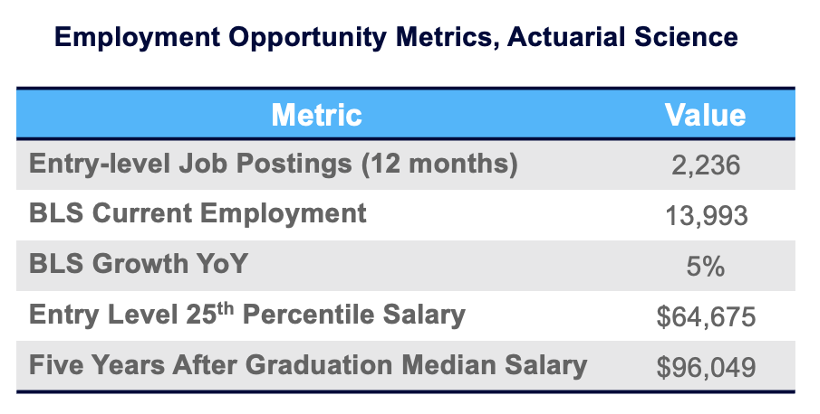To fully evaluate new and current academic programs requires labor data – and a lot more. Colleges and universities do need labor market data to ensure they offer programs and teach skills that lead to successful student employment outcomes. However, programs that lead to good jobs won’t necessarily attract students. We know institutions that have spent $500,000 and $1 million to develop programs and labs; between them, they enrolled five students a year. You need sound data on student demand and competition to avoid investing in empty classrooms and labs.
The Case of Actuarial Science Programs
A Bachelor’s in Actuarial Science holds strong employment prospects for graduates. Pay is high, as is job growth. Job posting volume is strong for a relatively small number of US graduates.

Source: Gray DI’s PES Markets
However, student demand data is weaker. IPEDS reports a four percent decline in 2022 completions year over year. Over the last three months, Google keyword searches for this program declined 15 percent year over year, indicating that fewer people are searching for Actuarial Science academic programs than last year. From Fall 2018 to 2023, total enrollment dropped annually by eight percent on average.

Source: Gray DI’s PES Program Enrollment Dashboard
The Case of Hospitality Administration/Management Programs
There are plenty of entry-level jobs for Bachelor’s in Hospitality Admin/Management graduates. Current employment is very high and growing. Job posting volume ranks in the 97th percentile against all other 1,500 IPEDS programs, and there are a healthy 2.8 entry-level jobs per graduate. Wages are not high, but the post-entry median salary is almost $75,000.

Source: Gray DI’s PES Markets
Student demand for hospitality programs is not entirely straightforward. The image below represents total, on-campus, and online completions over five years. Online program completions are growing, indicating increased demand in this modality, but the growth had a spike in 2021 that might inflate the five-year annual growth. The bump in 2021 could be related to COVID-19’s influence on online student demand.

Source: Gray DI’s PES Markets
While enrollment and Google searches also fell year-over-year, international student page views are high for this program, ranking in the 97th percentile against all other programs with 1,183 searches over the past year.
Evaluating an Academic Program? Look to the Details
When evaluating an academic program to start or grow, not only do you need student demand and employment data, but you also need to weigh the importance of each individual metric within those categories. While the Mechatronics, Robotics, and Automation Engineering program ranks in the 77th percentile for student demand and the 93rd percentile for employment, two metrics – international student demand and new enrollment – indicate potential growth. International page views rank in the 96th percentile for programs of similar size.

Source: Gray DI’s PES Markets
In Fall 2023, total enrollment grew 11 percent year-over-year; from Fall 2018 to 2023, it grew an average of 13% annually. This program could be a growth area despite the overall lower student demand ranking.




